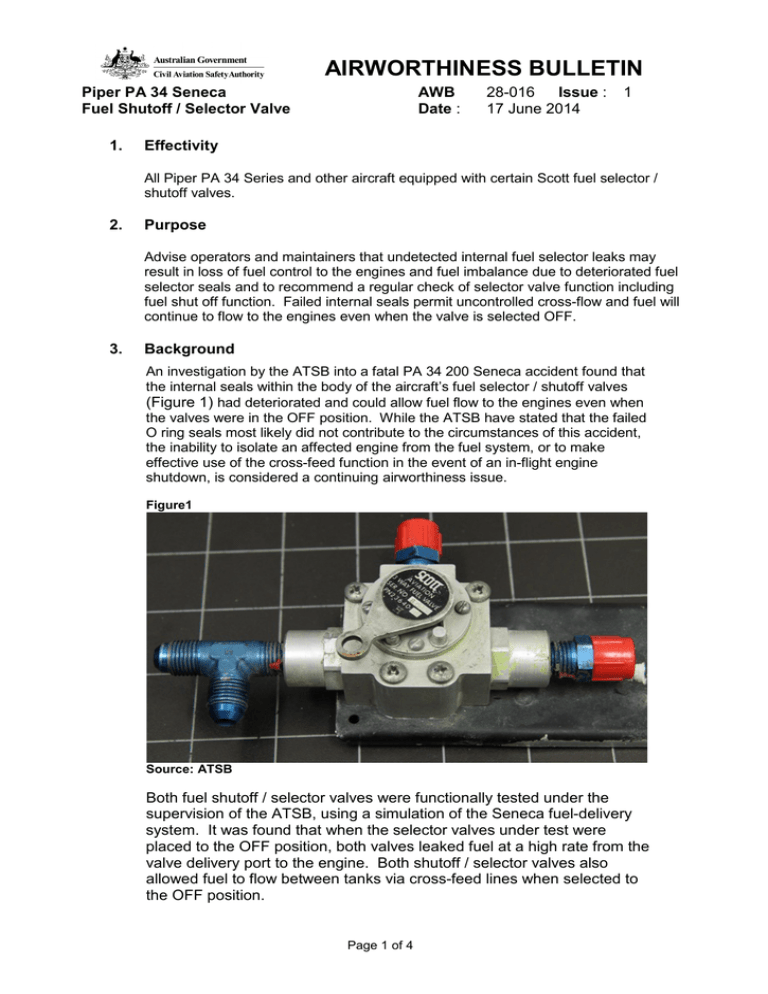AWB 28-016 Issue 1 - Piper PA34 Seneca Fuel Selector Valves
advertisement

AIRWORTHINESS BULLETIN Piper PA 34 Seneca Fuel Shutoff / Selector Valve 1. AWB Date : 28-016 Issue : 17 June 2014 1 Effectivity All Piper PA 34 Series and other aircraft equipped with certain Scott fuel selector / shutoff valves. 2. Purpose Advise operators and maintainers that undetected internal fuel selector leaks may result in loss of fuel control to the engines and fuel imbalance due to deteriorated fuel selector seals and to recommend a regular check of selector valve function including fuel shut off function. Failed internal seals permit uncontrolled cross-flow and fuel will continue to flow to the engines even when the valve is selected OFF. 3. Background An investigation by the ATSB into a fatal PA 34 200 Seneca accident found that the internal seals within the body of the aircraft’s fuel selector / shutoff valves (Figure 1) had deteriorated and could allow fuel flow to the engines even when the valves were in the OFF position. While the ATSB have stated that the failed O ring seals most likely did not contribute to the circumstances of this accident, the inability to isolate an affected engine from the fuel system, or to make effective use of the cross-feed function in the event of an in-flight engine shutdown, is considered a continuing airworthiness issue. Figure1 Source: ATSB Both fuel shutoff / selector valves were functionally tested under the supervision of the ATSB, using a simulation of the Seneca fuel-delivery system. It was found that when the selector valves under test were placed to the OFF position, both valves leaked fuel at a high rate from the valve delivery port to the engine. Both shutoff / selector valves also allowed fuel to flow between tanks via cross-feed lines when selected to the OFF position. Page 1 of 4 AIRWORTHINESS BULLETIN Piper PA 34 Seneca Fuel Shutoff / Selector Valve AWB Date : 28-016 Issue : 17 June 2014 1 Disassembly of the fuel selector valves identified serious deterioration of all the O rings on the internal moving spool assembly of each valve. A close examination of the O rings found that they had aged, and were either worn and cracked, or had slightly shrunk (Figure 2). Figure 2. Failed fuel selector spool seal. All four seals in both valves showed similar deterioration. Source ATSB Up to 30 October 2003, the Piper PA34 service manual provided maintenance instructions for the field overhaul and repair of the shutoff/selector valves, including replacement of the spool O rings, but need not be removed unless any of the following conditions existed: (a) Failure of selector lever to seat in detent, (b) Visible (external) fuel valve leaks, and (c) Difficultly in moving fuel selector lever. The Piper Service Manual revision dated 30 October 2003 removed the instructions for field overhaul and repair and at Section IX Fuel System Para 17 states: ‘CAUTION: No field disassembly or repair of fuel selector valves is authorized. Maintenance is limited to removal and replacement of the whole unit’ but still states that the fuel selector valve need not be removed unless it shows the same failure conditions as per (a) (b) (c) above. No test for internal leakage (fuel bypassing the spool O rings) is provided. It is also considered unlikely that internal fuel selector valve leakage would be detected by maintenance personnel following the current manufacturer’s maintenance program, or by pilots using the PA 34 Flight Manual pre-flight and taxi checks during normal operation. Page 2 of 4 AIRWORTHINESS BULLETIN Piper PA 34 Seneca Fuel Shutoff / Selector Valve AWB Date : 28-016 Issue : 17 June 2014 1 The fuel selector valves in the PA 34 are currently an on-condition item with no hard-time overhaul life, and the internal valve leakage identified as part of this investigation is not necessarily detectable through the current manufacturer’s maintenance schedule (CAR 42A). Background research shows that the Scott fuel selector/shutoff valve, Scott P/N 23640-5 (Piper P/N 492-189 or 461-737), as installed in the PA 34 Seneca, may also be used in other Piper aircraft models, including the PA-44 Seminole and PA-23 Aztec. 4. Recommendations Due to the critical functions that the fuel shutoff / selector valve performs in the PA34 Seneca and other Piper models, CASA recommends that operators and maintainers of these aircraft ensure particular attention is given at every 100 flight hours / annual inspections to complying with the following; 1. A detailed Functional Check of the fuel shutoff and cross feed system to verify that both fuel selector valves operate correctly and as designed including to “shut-off” the fuel supply to its corresponding engine. This can be verified during the periodic inspection task, “remove, drain and clean fuel gascolator bowls” where, during this task, it can be positively confirmed that the fuel selector has shut off the flow of fuel when selected to OFF. No amount of continued fuel flow (leakage) is acceptable. Note: the maintenance interval for the gascolator bowl task is every 90 days or 100 flight hours as per the Manufacturer’s Maintenance Schedule. 2. 5. Any selector valve found to fail the functional/ leakage checks is to be replaced before further flight. Reporting Defects related to any fuel selector/shutoff valves or operating cable failure or malfunction should be reported to CASA via the SDR system. Page 3 of 4 AIRWORTHINESS BULLETIN Piper PA 34 Seneca Fuel Shutoff / Selector Valve 6. AWB Date : 28-016 Issue : 17 June 2014 1 Enquiries Enquiries with regard to the content of this Airworthiness Bulletin should be made via the direct link e-mail address: AirworthinessBulletin@casa.gov.au or in writing, to: Airworthiness & Engineering Standards Branch Civil Aviation Safety Authority GPO Box 2005, Canberra, ACT, 2601 Page 4 of 4
